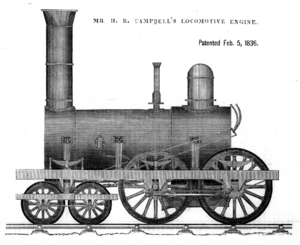4-4-0 locomotive

Front of locomotive at left
|
|||||||||||||||||||

1836 Patent drawing of the first 4-4-0 locomotive
|
|||||||||||||||||||
|
|||||||||||||||||||
|
|||||||||||||||||||
|
|||||||||||||||||||
| Equivalent classifications | |
|---|---|
| UIC class | 2′B |
| French class | 220 |
| Turkish class | 24 |
| Swiss class | 2/4 |
| Russian class | 2-2-0 |
| First known tank engine version | |
|---|---|
| First use | 1849 |
| Country | United Kingdom |
| Locomotive | GWR Bogie Class |
| Railway | South Devon Railway |
| Builder | Great Western Railway |
| First known tender engine version | |
|---|---|
| First use | 1836 |
| Country | United States of America |
| Railway | Philadelphia, Germantown and Norristown Railway |
| Designer | Henry Roe Campbell |
| Builder | Philadelphia, Germantown and Norristown Railway |
| Evolved from | 4-2-0 |
| Evolved to | 4-6-0 |
| Benefits | Better tractive effort than the 4-2-0 |
Under the Whyte notation for the classification of steam locomotives by wheel arrangement, 4-4-0 represents the arrangement of four leading wheels on two axles, usually in a leading bogie, four powered and coupled driving wheels on two axles, and no trailing wheels. Almost every major railroad that operated in North America in the first half of the 19th century owned and operated locomotives of this type. Due to the large number of the type that were produced and used in the United States, the 4-4-0 is most commonly known as the American type, but the type subsequently also became popular in the United Kingdom, where large numbers were produced.
The first use of the name American to describe locomotives of this wheel arrangement was made by Railroad Gazette in April 1872. Prior to that, this wheel arrangement was known as a standard or eight-wheeler. This locomotive type was so successful on railroads in the United States of America that many earlier 4-2-0 and 2-4-0 locomotives were rebuilt as 4-4-0s by the middle of the 19th century.
Several 4-4-0 tank locomotives were built, but the vast majority of locomotives of this wheel arrangement were tender engines.
Five years after new locomotive construction had begun at the West Point Foundry in the United States with the 0-4-0 Best Friend of Charleston in 1831, the first 4-4-0 locomotive was designed by Henry R. Campbell, at the time the chief engineer for the Philadelphia, Germantown and Norristown Railway. Campbell received a patent for the design in February 1836 and soon set to work building the first 4-4-0.
...
Wikipedia
